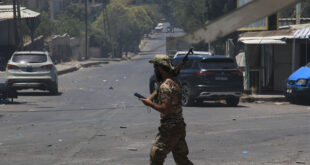Officials say they are working to equip vehicles with protection against deadly new weapons.WASHINGTON – The Army is working to fill a shortfall in Iraq of thousands of advanced Humvee armor kits designed to reduce U.S. troop deaths from roadside bombs – including a rising threat from particularly lethal weapons apparently linked to Iran and known as explosively formed penetrators (EFP) – that are now inflicting 70 percent of U.S. casualties in the country, according to U.S. military and civilian officials.
The extra protection is needed for thousands of U.S. reinforcements flowing into Baghdad, where these devastating weapons – used primarily by Shiite fighters – are particularly prevalent, the officials said.
U.S. Army units in Iraq and Afghanistan are short more than 4,000 of the latest Humvee armor kits, known as FRAG Kit 5, according to U.S. officials. The Army has ramped up production of the armor, giving priority to troops in Baghdad, but the upgrade is not scheduled to be completed until this summer, Army officials said. That is well into the timeline for major operations launched last week to quell violence by Sunni insurgents and Shiite militias, which the U.S. military now views as the top security threat in Iraq.
“Those who need FRAG Kit 5 are receiving FRAG Kit 5 based upon theater requirements and priorities,” said Army Brig. Gen. Charles Anderson, director of force development for the Army deputy chief of staff. The Army is supplying the life-saving kits “as quickly as we can,” he said in an interview and in written responses.
The Army would not say how many kits have been installed or where shortages exist.
The Army began the Iraq war with an estimated $56 billion equipment shortage and has struggled to keep up with demand for new armor to protect against increasingly deadly bombs. In the case of FRAG Kit 5, the Army quickly produced a bolt-on version in limited quantities, while the permanent version has taken longer than expected to develop, test, produce and install. Meanwhile, the deployment of five additional Army brigades in Baghdad has created an urgent need for 2,000 Humvees with the new armor.
Shiite forces in recent months have stepped up their targeting of U.S. soldiers in Baghdad with sophisticated EFPs, described by one official as being like “a spear that rips right through the vehicle.”
The penetrator, a heavy, metal projectile, is propelled by an explosive and strikes with enough speed and power to shatter the relatively brittle “high hard” steel of up-armored Humvees, creating what experts call “behind armor debris (BAD)” – essentially, turning pieces of the vehicle into shrapnel. The new armor kit is designed with more flexible materials that slow the projectile and contain the debris, limiting the damage to that caused directly by the EFP.
There is no guarantee, however, that even the latest armor can prevent deaths from EFPs, senior defense officials have emphasized, and U.S. troops in Humvees outfitted with the new kit have been killed by EFPs.
The Pentagon does not release overall data on EFP strikes or their effectiveness, to prevent attackers from exploiting such information. But reports from the military and family members on specific attacks indicate that since November, at least 11 U.S. soldiers and an interpreter have died in strikes caused by EFPs, all but one of them in Baghdad.
“In November there was all of a sudden a ridiculous surge in EFP activity. People were getting killed left and right,” said one military officer who served recently in Iraq. While other roadside bombs often cause no casualties, EFPs “make everyone nervous,” he said. “It’s a catastrophic weapon.”
Senior U.S military officials in Baghdad held a briefing yesterday in which they presented evidence of apparent Iranian involvement in supplying EFP technology and components to fighters in Iraq.
EFP attacks are a small percentage of the roughly 1,200 attacks against U.S. forces each month involving roadside bombs, according to the Pentagon’s Joint IED Defeat Organization. About half all roadside bombs in Iraq are found and disabled, and only 20 percent cause U.S. casualties. But EFPs “are far more lethal,” Defense Secretary Robert Gates said recently. “They can take out an Abrams tank.”
 Eurasia Press & News
Eurasia Press & News



